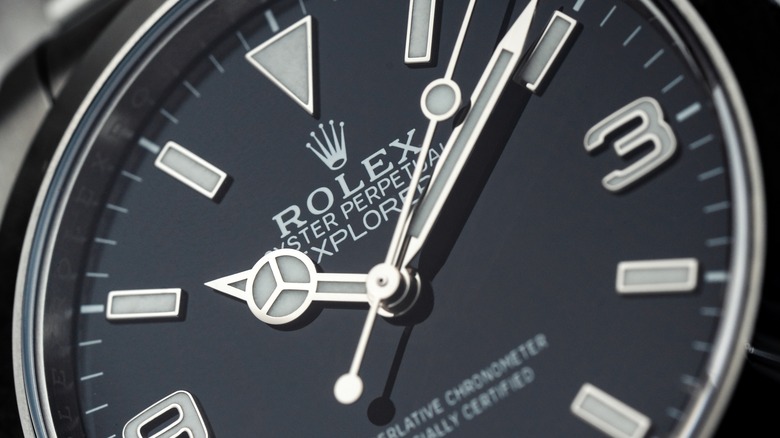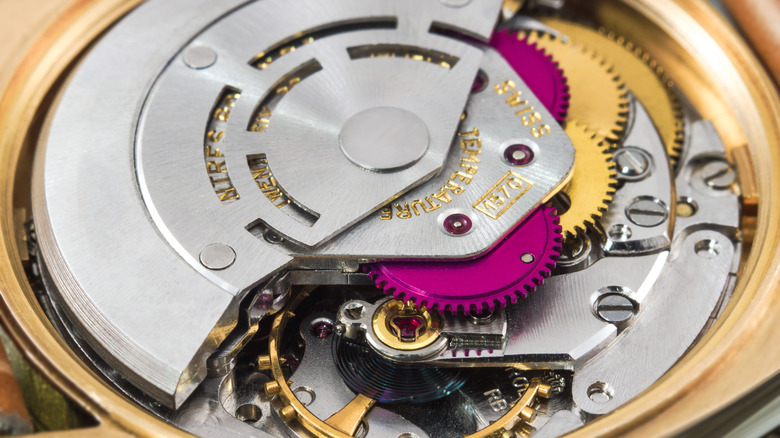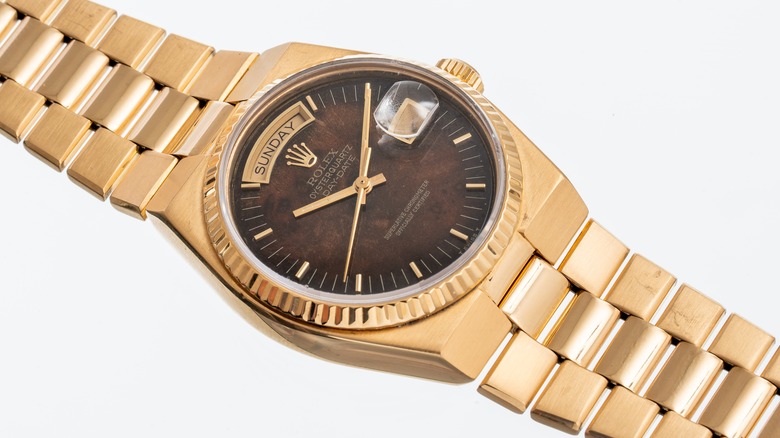Here's How A Rolex Watch Runs Without A Battery
When most people think about what makes a watch tick, a battery is probably the first thing that comes to mind. How else could it run, right? Well, Rolex, one of the most famous luxury watch brands in the world, has built its luxury empire on something completely different. Other than one short-lived experiment with the Oysterquartz, every Rolex ever made has run without a single drop of battery power.
Instead of using a battery, Rolex created the Perpetual rotor in 1931, which powers their watches with what seems like mechanical magic. Inside the watch is a small, weighted piece of metal shaped like a half-circle. As you move your wrist, whether you're walking, typing, or even just shifting in your chair, the weight spins around and captures every movement. In turn, this energy winds a spring that's tightly coiled inside the watch. The spring then slowly unwinds, feeding power through a gear train that smoothly moves the hands in Rolex's signature fashion.
The best thing about this setup is its longevity. A well-maintained Rolex can tick on for decades with occasional servicing, far outlasting its battery-powered counterparts. It's a beautiful system that keeps the watch connected to its wearer.
The perpetual power of a Rolex
The heart of a Rolex is as much art as it is engineering. The Perpetual rotor is made from a dense tungsten alloy that is specifically chosen to detect even the most subtle shift of your arm. The mainspring, which is stored inside a protective cylinder called the mainspring barrel, stores all the energy collected from the wearer's movements. Once the mainspring is fully wound, a hidden clutch engages to prevent any damage from overwinding.
The stored kinetic energy is then translated into motion through precisely controlled bursts. These calculated releases of power happen through a series of gears that turn the wheel train. This wheel swings back and forth at a specific rhythm that regulates the time with remarkable precision.
Thanks to their ability to store energy, modern Rolex watches are capable of running for two or three days when not being worn. If you let it rest too long, all it takes is a quick twist of the crown, and it will be ticking again with no issues. For those reasons, vintage Rolex watches might be an old gadget worth buying today.
The one Rolex without a mechanical heart
Rolex has built its reputation on mechanical mastery, but for a brief chapter in the late 20th century, it decided to try something new. Back in 1977, Japanese quartz watches were stealing the show from the Swiss, resulting in the Quartz Crisis. This led the company to introduce the Oysterquartz, its only ever battery-powered timepiece. The Oysterquartz stood out aesthetically as much as it did mechanically. Its square case with rounded corners and integrated bracelet make it instantly recognizable when compared to other Rolexes. Rolex stopped making the watch in 2001, after producing only about 24,000, making it a sought-after piece for collectors.
One of the many myths surrounding luxury watches is that quartz watches are always better. Rolex tested that theory, and while they showcased their ability to master battery power with the Oysterquartz, it ultimately reaffirmed the brand's identity. Today's Submariners, Datejusts, and GMT-Master IIs all share the same tangible connection to wearers with their mechanical hearts.


